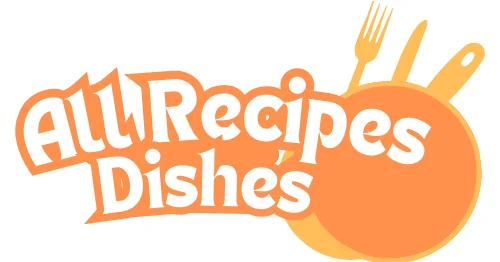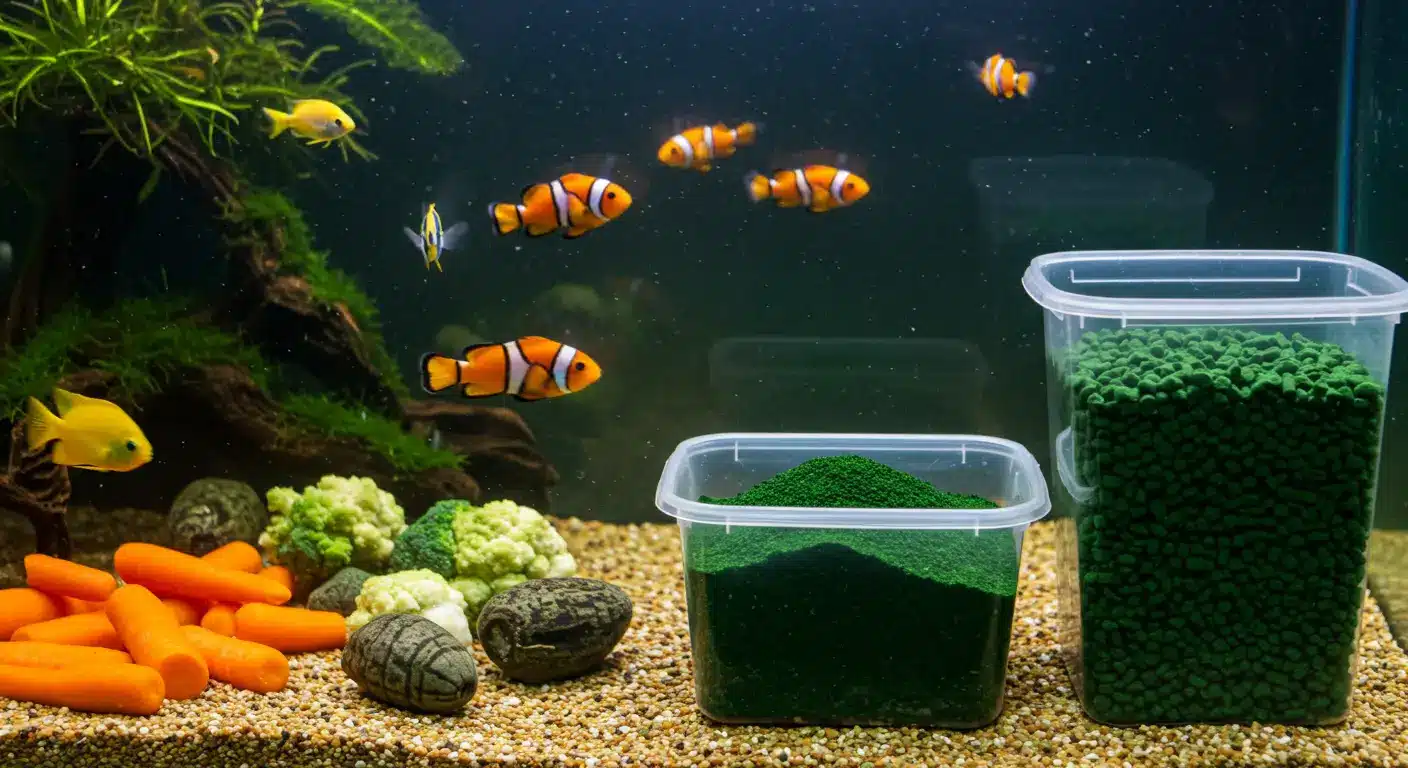Easy Fish Food Recipes to Try at Home
Keeping your aquatic pets healthy is key. Making homemade fish food is a great way to do this. It lets you choose the right ingredients for them, avoiding bad stuff in store-bought food.
It’s not hard to make your own fish food recipe at home. Just a few ingredients can make a meal your fish will enjoy. Plus, it saves money and keeps your pets happy and healthy.
Table of Contents
Why Make Your Own Fish Food?
Making your own fish food is easy and good for your fish. You can pick the ingredients to match what your fish need. This can make them healthier and live longer.
Nutritional Benefits for Your Aquatic Pets
Homemade fish food lets you add many nutrients. You can use protein sources like fish, shrimp, or squid. Add veggies like spinach or zucchini for extra vitamins and minerals.
This way of feeding your fish can make them look and feel better. It’s a smart move for their health.
Cost Savings Over Commercial Options
Homemade fish food can also save you money. Buying ingredients in bulk and making lots at once is cheaper. You also skip the additives and preservatives in store-bought foods.
This makes your fish healthier and can save you money over time. Both you and your fish benefit from this arrangement.
Essential Ingredients for Homemade Fish Food
To keep your aquatic pets thriving, it’s crucial to know the key components of a nutritious homemade fish diet. A balanced diet is vital for the health and well-being of your fish. Making your own fish food allows you to tailor the ingredients to their specific needs.
Protein Sources
Protein is a critical component of a healthy fish diet. You can use various protein sources such as fish meat, shrimp, and even insects. For example, brine shrimp and bloodworms are excellent protein-rich foods that can be included in your DIY fish food recipes.
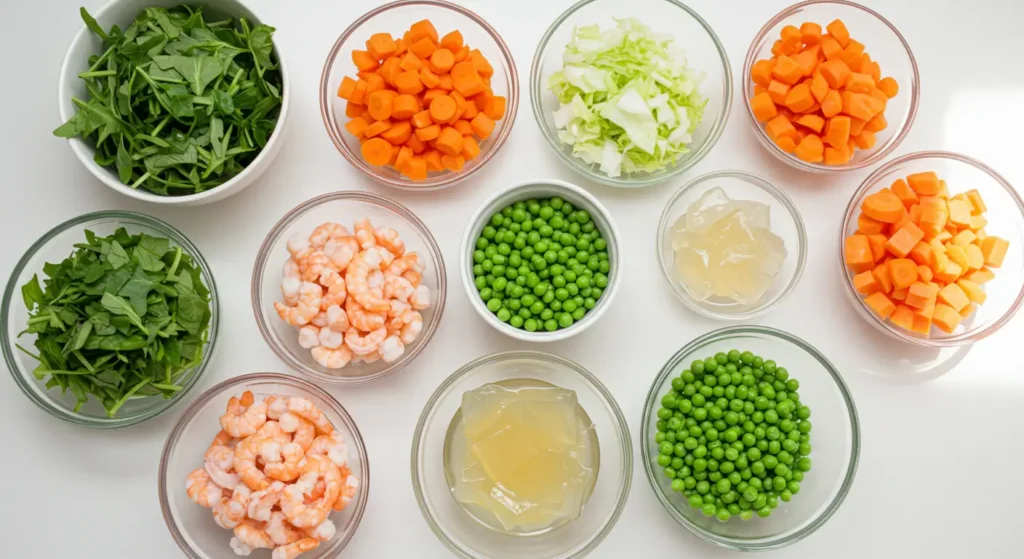
Vegetable Components
Adding vegetables boosts the fiber and key nutrients in fish meals. Spirulina, peas, and zucchini are popular choices that provide a nutrient-rich supplement to your fish’s diet. Incorporating a variety of vegetables ensures a well-rounded diet.
Vitamins and Supplements
Adding vitamins and supplements can enhance the nutritional value of your homemade fish food. Vitamins C and E, along with minerals like calcium, are crucial for maintaining your fish’s health. Consider consulting with an aquatic expert to determine the best supplements for your fish.
Required Equipment and Preparation
Making homemade fish food is easy with the right tools and preparation. You’ll need basic kitchen tools and a place to store your fish food. The right equipment makes the process simpler and keeps your fish food healthy.
Basic Kitchen Tools You’ll Need
You’ll need a food processor or blender, a mixing bowl, and measuring cups and spoons. Using a kitchen scale helps measure ingredients accurately. Avoid using tools made from reactive materials like aluminum, as they can contaminate your fish food.
Storage Containers and Options
After making your fish food, you’ll need to store it to keep it fresh. Airtight containers are best for this. You can use glass jars or plastic containers. For longer storage, freeze your fish food. Label your containers with the date and contents to keep track of what you have stored.
| Storage Method | Container Type | Shelf Life |
|---|---|---|
| Refrigeration | Airtight Containers | Up to 1 week |
| Freezing | Freezer-safe Containers or Bags | Up to 3 months |
Basic Fish Food Recipe for Beginners
If you’re new to making fish food at home, this recipe is perfect for you. It needs just a few ingredients and tools. This makes it simple to start making your own fish food.
Ingredient List
The ingredients for this basic fish food recipe include:
- 1 cup of fresh or frozen fish fillet (such as salmon or cod)
- 1/2 cup of spinach or kale
- 1/4 cup of cooked and mashed sweet potato
- 1 tablespoon of fish oil
- 1 teaspoon of spirulina powder (optional)
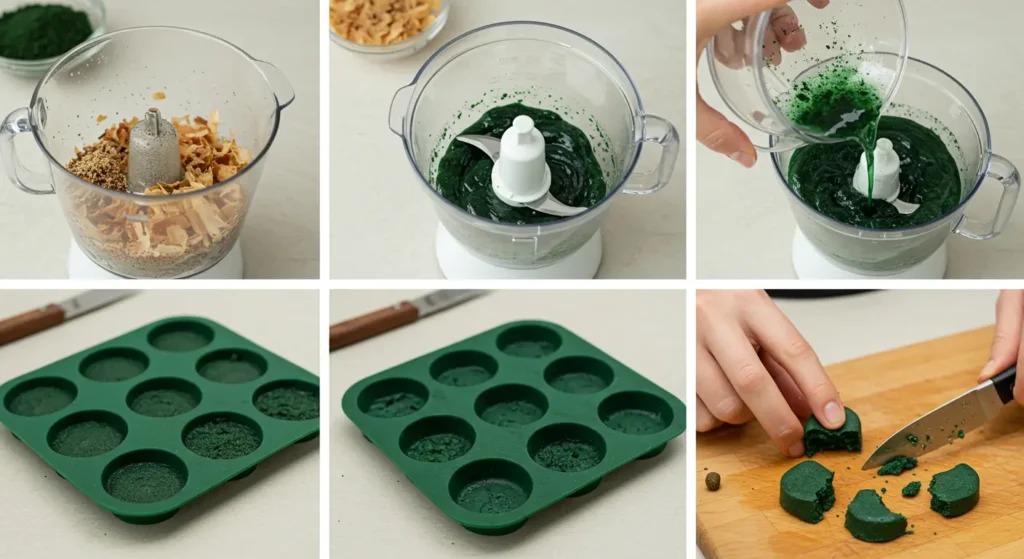
Preparation Steps
To prepare this fish food, follow these steps:
- Blend the fish fillet, spinach or kale, and sweet potato in a food processor until well combined.
- Add the fish oil and spirulina powder (if using) to the mixture and blend until smooth.
- Shape the mixture into small pellets or cubes, depending on the size of your fish.
- Store the prepared fish food in an airtight container in the refrigerator or freezer.
Feeding Guidelines
Start by replacing 25% of your fish’s commercial food with this homemade recipe. Watch for any signs of digestive issues or stress. Adjust the amount as needed. It’s also key to change up the ingredients to keep your fish’s diet balanced.
| Ingredient | Nutritional Benefit |
|---|---|
| Fish Fillet | High-quality protein source |
| Spinach/Kale | Rich in vitamins and antioxidants |
| Sweet Potato | Complex carbohydrate source |
Specialized Fish Food Recipes for Different Species
Different fish need different foods to stay healthy. Creating customized fish food recipes supports better fish health. It boosts their health, color, and energy.
Tropical Fish Food Recipe
Tropical fish need lots of protein and vitamins. Here’s a simple recipe for them.
Ingredients
Use brine shrimp, spirulina, and veggies like peas and carrots. Add high-quality flake food too.
Preparation Method
Blend the ingredients. Then shape them into small pellets for your tropical fish.
Feeding Instructions
Feed your tropical fish 2-3 times a day. Feed just enough for your fish to finish within a few minutes.
Goldfish and Koi Food Recipe
Goldfish and koi need carbs, proteins, and veggies in their diet.
Ingredients
Start with wheat germ, peas, and daphnia. Add commercial pellets too.
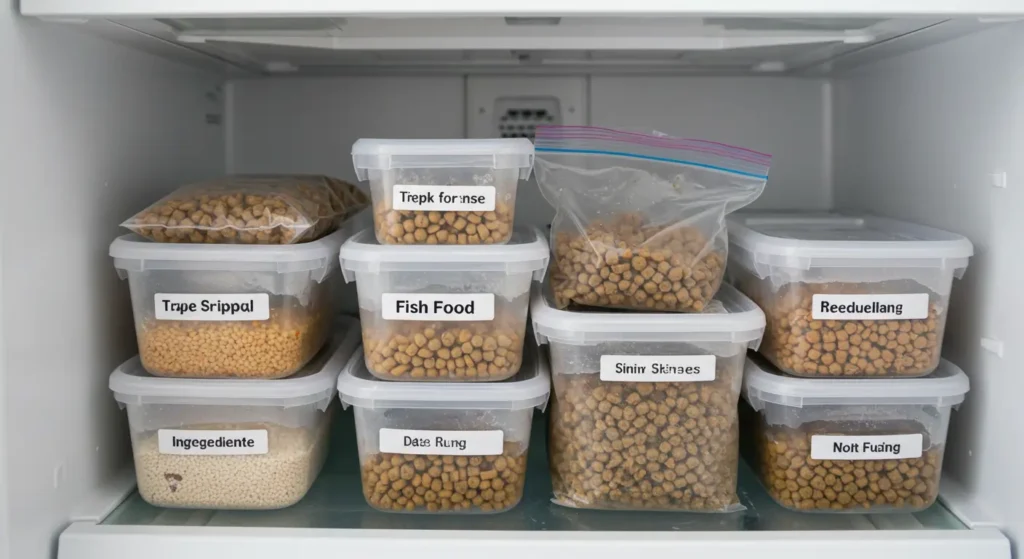
Preparation Method
Mix the ingredients into a dough. Shape into small pieces and freeze until firm.
Feeding Instructions
Feed your goldfish and koi 1-2 times daily. Avoid overfeeding to keep water quality good.
Betta Fish Food Recipe
Betta fish are meat-eaters and need lots of protein.
Ingredients
Base your betta food on bloodworms, brine shrimp, and high-protein betta food.
Preparation Method
Make a paste from the ingredients. Then shape into small pieces.
Feeding Instructions
Feed your betta fish 2-3 times a day. Give them as much as they can eat in a few minutes.
These recipes offer a healthy and balanced diet for your fish. “Dr. James Findlay, a renowned aquaculture expert, notes,” ‘A well-nourished fish is not just healthier but also more vibrant and engaging to watch.’
‘The nutritional needs of fish vary significantly across different species, and understanding these needs is crucial for their health and well-being.’
Dr. Sandra Gomez, Aquatic Biologist
Storage and Shelf Life of Your Fish Food Recipe
After making your DIY fish food, it’s key to store it right. This keeps it fresh and safe for your fish. Proper storage is crucial for maintaining quality.
Refrigeration Methods
Refrigeration works well for short-term storage. Use airtight containers to keep it fresh and prevent contamination. Store these in the fridge at a temperature below 40°F (4°C). This is best for using the food in a few days.
Freezing Techniques for Longer Preservation
Freezing is great for longer storage. Store food in freezer-safe containers or bags to prevent freezer damage. Remember to label them with the date and what’s inside. Store at 0°F (-18°C) or lower. Freezing keeps your fish food fresh and nutritious for weeks or months.
Making Homemade Fish Food: A Rewarding Experience
You now know how to make nutritious homemade fish food. Making your own food lets you pick the ingredients. This ensures your fish get the best nutrition.
With the recipes and tips from this article, you can give your fish a balanced diet. Try out different ingredients and recipes to see what your fish like best. You’ll save money and improve their nutrition.
As you keep caring for your fish, think about the long-term benefits of homemade food. By choosing their food yourself, you help keep them healthy. This makes your aquarium a happier place for everyone.
FAQs
What are the benefits of making my own fish food at home?
Making your own fish food at home lets you control what your fish eat. This can make them healthier and live longer. It also might save you money compared to buying commercial food.
What are the essential ingredients for making homemade fish food?
The key ingredients are proteins like fish, shrimp, or eggs. You also need veggies like spinach or zucchini. Don’t forget vitamins and supplements for a balanced diet.
How do I store homemade fish food to maintain its freshness?
Keep homemade fish food in airtight containers in the fridge for a few days. For longer storage, freeze it. Use airtight containers or freezer bags to avoid freezer burn.
Can I make fish food for different species of fish?
Yes, you can make special fish food for different types, like tropical fish or goldfish. Each recipe can be adjusted for your fish’s specific needs.
How often should I feed my fish homemade fish food?
Feeding frequency depends on your fish’s type, age, and size. Usually, feed them 2-3 times a day. But, be careful not to overfeed to keep the water clean.
What are some common mistakes to avoid when making homemade fish food?
Don’t use low-quality ingredients or forget to store food properly. Use fresh ingredients, follow a balanced recipe, and store food correctly to keep it nutritious.
Can I customize homemade fish food recipes for my fish’s specific needs?
Yes, you can tailor homemade fish food to your fish’s needs. Consider their species, age, size, and health. Ask a vet or aquatic expert for the best recipe for your fish.
